Did you know that pruning tomato plants is an optional technique that can have a significant impact on plant health and fruit production? Whether you’re a seasoned gardener or a beginner, understanding the art of pruning can help you optimize the growth and harvest of your tomato plants.
Key Takeaways:
- Pruning tomato plants can improve plant health and increase fruit size.
- Indeterminate varieties are the best candidates for pruning.
- Pruning offers benefits such as improved airflow, bigger fruit, and earlier ripening.
- Avoid pruning determinate varieties as it may reduce the overall harvest.
- The timing and techniques of pruning tomato plants are crucial for optimal results.
Benefits of Pruning Tomato Plants
Pruning tomato plants has numerous benefits that contribute to their overall health and fruit production. By carefully trimming and removing specific parts of the plant, gardeners can optimize the growth and development of their tomatoes. Here are some compelling reasons why you should consider pruning your tomato plants:
- Improved Airflow: Pruning tomato plants promotes better airflow throughout the foliage. This is crucial for reducing the risk of diseases caused by prolonged moisture, such as fungal infections and blight. Proper airflow helps keep the plant’s leaves dry and prevents the spread of pathogens.
- Enhanced Fruit Development: When you prune tomato plants, you direct the plant’s energy towards fruit production. By removing excess foliage and non-essential branches, you create a more focused allocation of nutrients and resources to the developing fruit. This results in larger and more robust tomatoes.
- Earlier Ripening: Pruned tomato plants tend to ripen earlier, especially in climates with shorter growing seasons. By removing unnecessary growth, you allow the plant to channel its energy into producing and maturing fruit. This can be particularly advantageous if you live in an area with a limited growing period.
“Pruning tomato plants not only improves airflow and disease resistance but also encourages the plant to prioritize fruit production, resulting in bigger and tastier tomatoes.” – Tomato enthusiast
In addition to these benefits, pruning can also help maintain the overall shape and structure of the plant, making it easier to support and manage as it grows. To further illustrate the advantages of pruning tomato plants, take a look at the table below:
| Benefits of Pruning Tomato Plants | Explanation |
|---|---|
| Improved airflow | Pruning creates space between branches, allowing air circulation and reducing humidity, which can prevent diseases. |
| Enhanced fruit development | By redirecting resources from non-essential growth to fruit production, pruning results in larger and more abundant tomatoes. |
| Earlier ripening | Removing unnecessary foliage and focusing on fruit production can expedite the ripening process, particularly in shorter growing seasons. |
As you can see, pruning tomato plants offers a range of benefits that contribute to healthier plants, improved fruit quality, and more successful harvests. In the following section, we will explore the best timing for pruning tomato plants. But before that, take a break and enjoy this visual representation of pruned tomato plants:
When to Prune Tomato Plants
Pruning tomato plants is a key part of their care, but knowing when to prune is equally important for successful growth and abundant harvests. Proper timing ensures that pruning doesn’t hinder plant development or fruit production. Here’s a guide on the best times to prune tomato plants throughout the growing season.
At Planting:
When transplanting your tomato seedlings into the garden, it’s recommended to perform some initial pruning. Removing lower leaves and any flowers present at planting helps redirect the plant’s energy towards establishing a strong root system and encouraging healthy, leafy growth.
Early in the Season:
As your tomato plants start to grow, it’s important to remove flowers until they reach a height of 12-18 inches. This allows the plants to focus their energy on developing a strong root system and robust foliage. Pruning early in the season encourages better fruit production later on.
Optimizing Fruit Development:
To promote optimal fruit development, it’s necessary to remove leafy suckers that appear beneath the first fruit cluster. These suckers divert energy away from the main stems and fruit, hindering their growth and reducing overall productivity. By removing these suckers, your tomato plants can concentrate their resources on producing bigger and healthier fruit.
Late in the Season:
As the growing season comes to an end, it’s important to prepare your tomato plants for the transition into fall. About four weeks before the expected first fall frost, remove the growing tip of each main stem. This action redirects the plant’s energy towards maturing existing fruit, allowing them to ripen faster before the colder weather sets in.
By following these pruning guidelines at the appropriate times, you can ensure that your tomato plants thrive and produce an abundant, flavorful harvest.
How to Prune Indeterminate Tomato Plants
Pruning indeterminate tomato plants is an essential technique for maintaining plant health and maximizing fruit production. By removing suckers, you can ensure that the plant’s energy is directed towards fruit development. Here are some pruning techniques to help you get the most out of your tomato plants:
- Identify the suckers: Indeterminate tomato plants produce suckers, which are small shoots that grow between the main stem and branches. These suckers can divert energy from fruit production if left unchecked.
- Pinch off small suckers: For small suckers, you can simply pinch them off using your fingers. This method is quick and doesn’t require any tools.
- Prune larger suckers: If you encounter larger suckers, you may need to use pruning tools such as pruning shears or scissors. Make clean cuts close to the main stem to prevent unnecessary damage.
Missouri Pruning Technique
“Missouri pruning is a technique where only the tip of the sucker is removed, leaving a couple of leaves to protect developing fruit from sunburn.”
This method is particularly useful for preventing sunburn on the developing fruit. By leaving a couple of leaves on the sucker, you provide shade and protection. Remember to regularly monitor and prune the suckers throughout the growing season to maintain plant vigor and encourage proper fruit development.
| Benefits of Pruning Indeterminate Tomato Plants | Pruning Techniques |
|---|---|
| 1. Improves airflow around the plant, reducing the risk of diseases caused by excessive moisture. | 1. Identify and pinch off small suckers. |
| 2. Directs energy towards fruit development, resulting in larger and more abundant harvests. | 2. Prune larger suckers close to the main stem. |
| 3. Helps tomatoes ripen earlier, especially in short-season climates. | 3. Employ Missouri pruning technique to protect developing fruit from sunburn. |
Common Tomato Pruning Mistakes to Avoid
Pruning tomato plants is a crucial aspect of their care, but it’s essential to avoid common mistakes that can harm your plants and reduce fruit production. By being aware of these tomato pruning mistakes, you can ensure your plants thrive and yield a bountiful harvest.
- Pruning determinate tomato plants: Determinate varieties have a predetermined number of stems, leaves, and flowers. Pruning these plants can interfere with their natural growth and reduce the overall harvest. It’s best to avoid pruning determinate tomato plants altogether.
- Pruning when plants are wet: Pruning tomato plants when they are wet can increase the risk of spreading diseases. Moisture provides an ideal environment for pathogens to thrive and infect your plants.
- Using dirty pruning tools: Using dirty or contaminated pruning tools can introduce pathogens to the plants, leading to infections. Before pruning, make sure to clean and sterilize your tools to prevent the spread of diseases.
- Waiting too long to prune: Delaying pruning can result in heavy, overgrown branches that are difficult to manage. It can also restrict airflow and sunlight penetration, leading to reduced fruit production. Prune your tomato plants regularly throughout the growing season.
- Over-pruning: While pruning is beneficial, over-pruning can be detrimental. Removing too many leaves and suckers can expose the fruits to direct sunlight, causing sunscald and damage. It’s important to strike a balance and avoid excessive pruning.
- Not topping main stems at the end of the season: Topping the main stems by removing the growing tips helps redirect energy into ripening the remaining fruits. Failure to top the main stems can prolong the ripening process and affect the overall quality of the fruit.
Avoiding these tomato pruning mistakes will help you maintain healthy and productive plants. Pruning plays a vital role in promoting plant growth and maximizing fruit production, so ensure you follow proper pruning techniques and care for your tomato plants throughout their growing season.
Proper Pruning Techniques for Tomato Plants
When it comes to maintaining healthy and productive tomato plants, proper pruning is key. By following correct tomato pruning methods, you can enhance fruit production and ensure optimal plant growth. Let’s dive into the step-by-step process of how to prune tomato plants.
To start, identify the main stem of the tomato plant. This is the central vertical stem that supports the entire plant. Once you’ve located the main stem, keep an eye out for the suckers. Suckers are small, leafy growths that emerge from the “V” between the main stem and branches.
Now, it’s time to get rid of those suckers. Remove all the suckers except for the strongest one that is situated just below the lowest fruit cluster. This allows the plant to focus its energy on producing fruit and encourages healthy growth.
It is important to remove suckers when they are small to prevent them from diverting energy away from fruit production. Waiting too long to remove suckers can result in decreased fruit size and overall plant health.
Remember, cleanliness is crucial when pruning tomato plants. Dirty tools can spread diseases from plant to plant. Therefore, always use clean tools and disinfect them before and after each use. This helps prevent the spread of pathogens and ensures the long-term health of your tomato plants.
Pro Tip: Pruning tomato plants is best done in the morning or on a cloudy day to minimize stress on the plants.
By employing these proper pruning techniques, you can effectively promote fruit growth and maximize the potential of your tomato plants. Keep in mind that different tomato varieties may require specific pruning approaches, so familiarize yourself with the specific needs of your plants.
Dos and Don’ts of Pruning Tomato Plants
| Do | Don’t |
|---|---|
| Identify and remove suckers except for the strongest one below the lowest fruit cluster | Prune determinate tomato plants |
| Prune suckers when they are small to prevent energy diversion | Prune tomato plants when they are wet |
| Use clean tools and disinfect them before and after pruning | Over-prune and remove excessive foliage |
By adhering to these pruning techniques and guidelines, you can harness the full potential of your tomato plants and enjoy a bountiful harvest.
Pruning Recommendations by Tomato Type
When it comes to pruning tomato plants, it’s important to consider the type of tomato plant you have. Determinate tomato plants have a predetermined growth pattern, while indeterminate tomato plants continue to grow and produce fruit throughout the season. Let’s explore the pruning recommendations for each type:
Determinate Tomato Plants
Determinate tomato plants are often referred to as “bushy” tomatoes. They have a compact growth habit and reach a predetermined height. Unlike indeterminate plants, determinate tomatoes do not require extensive pruning. However, I recommend removing suckers below the first flower cluster. This allows the plant to focus its energy on fruit production rather than excess foliage growth.
Indeterminate Tomato Plants
Indeterminate tomato plants are known for their vining growth habit and unlimited potential for growth. Pruning indeterminate tomato plants can help improve airflow, reduce the risk of diseases, and direct energy towards fruit development. To prune an indeterminate tomato plant, follow these steps:
- Identify the main stem of the plant.
- Inspect the “V” between the main stem and the branches, where suckers usually form.
- Pinch off small suckers using your fingers or use pruning shears for larger ones. Remember to make clean cuts to minimize damage to the plant.
It’s important to regularly prune indeterminate tomato plants throughout the season to maintain optimal growth and productivity.
By understanding the pruning recommendations for each tomato type, you can ensure that your plants receive the care they need for healthy growth and abundant fruit production.
Pruning Tips for Optimal Tomato Plant Health
Pruning tomato plants is just one aspect of proper tomato plant care. To ensure healthy and productive plants, it’s essential to follow best practices throughout the growing season. Here are some essential tips:
- Start with healthy young plants: Choose high-quality seedlings or start tomatoes from seeds. Look for disease-resistant varieties to minimize potential issues.
- Plant in well-draining, nutrient-rich soil: Tomatoes thrive in soil that drains well and is rich in organic matter. Prepare the soil before planting by incorporating compost or aged manure.
- Regularly fertilize with organic plant food: Feed your tomato plants with a balanced organic fertilizer to provide essential nutrients for healthy growth. Follow the instructions on the package for application rates and timings.
- Combine pruning with other maintenance practices: Pruning should be part of a comprehensive plant care routine. Along with pruning, remove lower leaves to prevent soil-borne diseases from splashing onto the foliage.
| Benefits of Proper Tomato Plant Care | Consequences of Neglecting Tomato Plant Care |
|---|---|
|
|
“Proper tomato plant care, including pruning and maintenance, is essential for maximizing yield and ensuring plant health. By following these tips, you can set your tomato plants up for success and enjoy a bountiful harvest.”
Conclusion
Pruning tomato plants is an essential practice that can greatly enhance the overall health and productivity of your plants. By following proper pruning techniques and avoiding common mistakes, you can ensure stronger, healthier plants and enjoy a bountiful harvest of delicious tomatoes.
When pruning tomato plants, it’s crucial to consider the specific needs of your plant type. Indeterminate varieties benefit the most from pruning, as it helps to direct energy towards fruit development and promotes better airflow, ultimately resulting in larger fruit and earlier ripening. On the other hand, determinate varieties have a predetermined number of stems, leaves, and flowers, and should not be pruned extensively.
In addition to pruning, remember to implement other essential plant care practices for optimal results. Start with healthy young plants and plant them in nutrient-rich soil with proper drainage. Regularly fertilize your plants with organic plant food and remove lower leaves to prevent soil-borne diseases from splashing onto the foliage. By combining these practices, you can create an ideal environment for your tomato plants to thrive.
So, whether you’re a seasoned gardener or just starting out, don’t overlook the importance of tomato plant pruning and care. With attention to detail and a little bit of effort, you’ll enjoy healthier plants and a more abundant harvest of juicy, flavorful tomatoes.

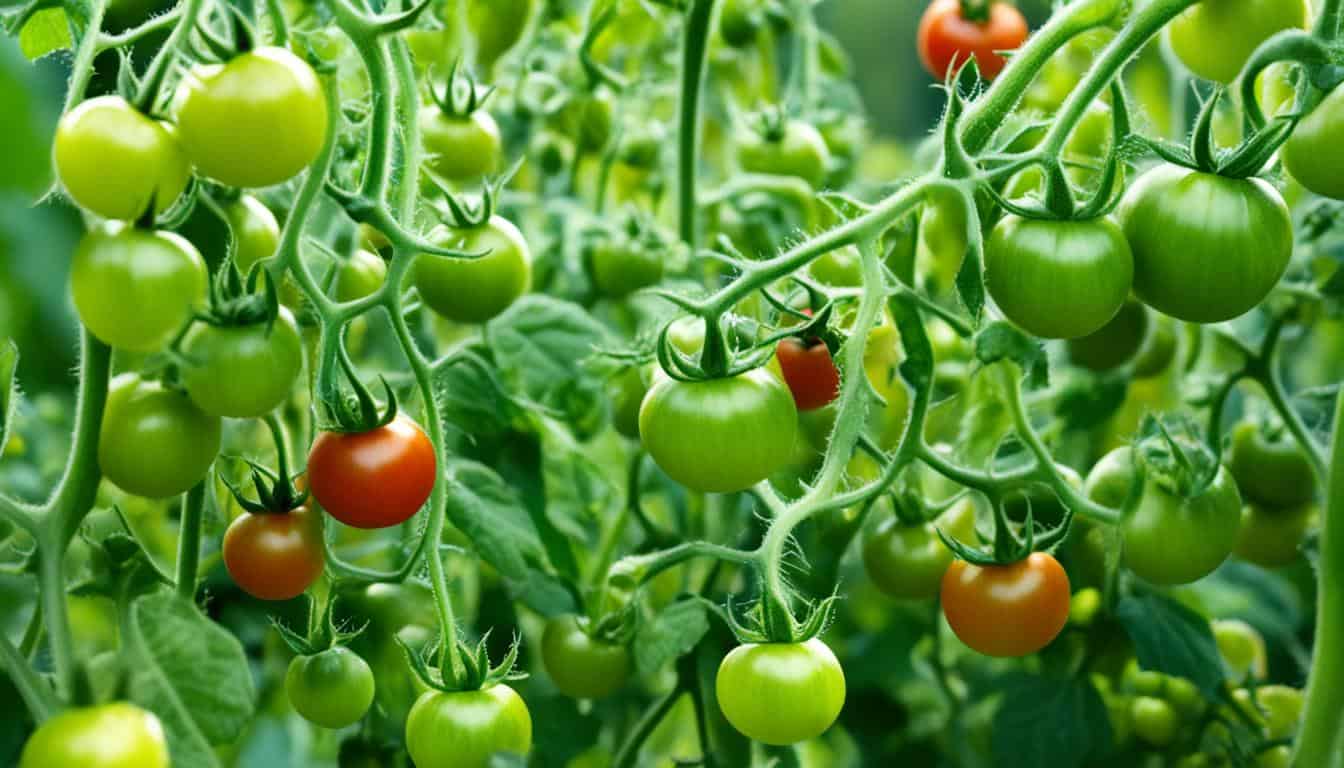
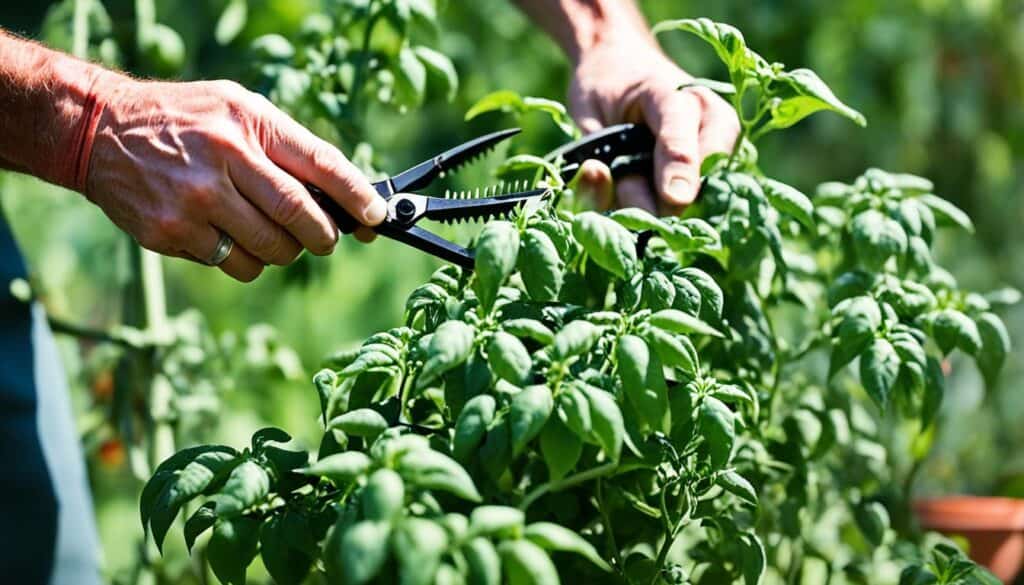
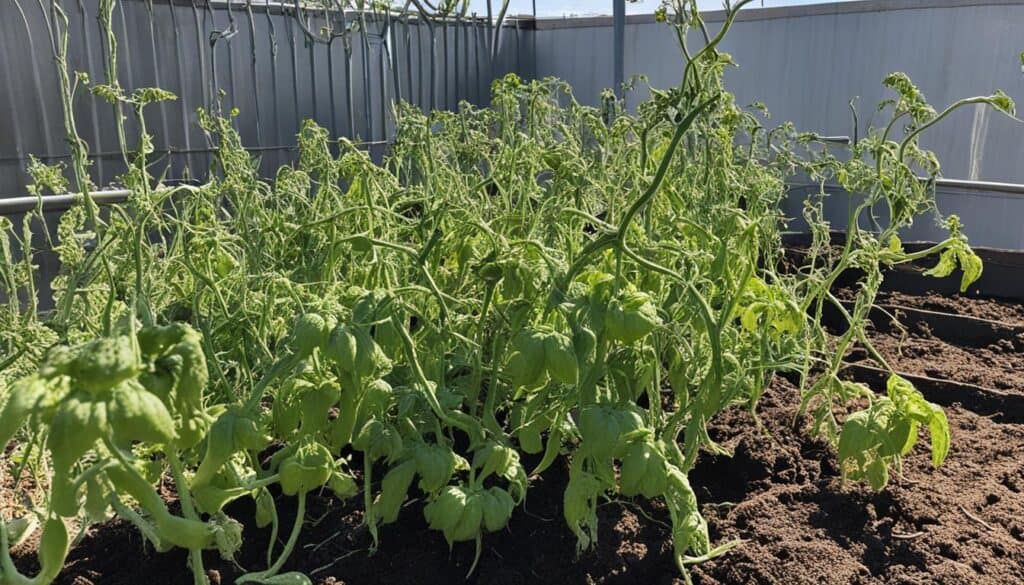
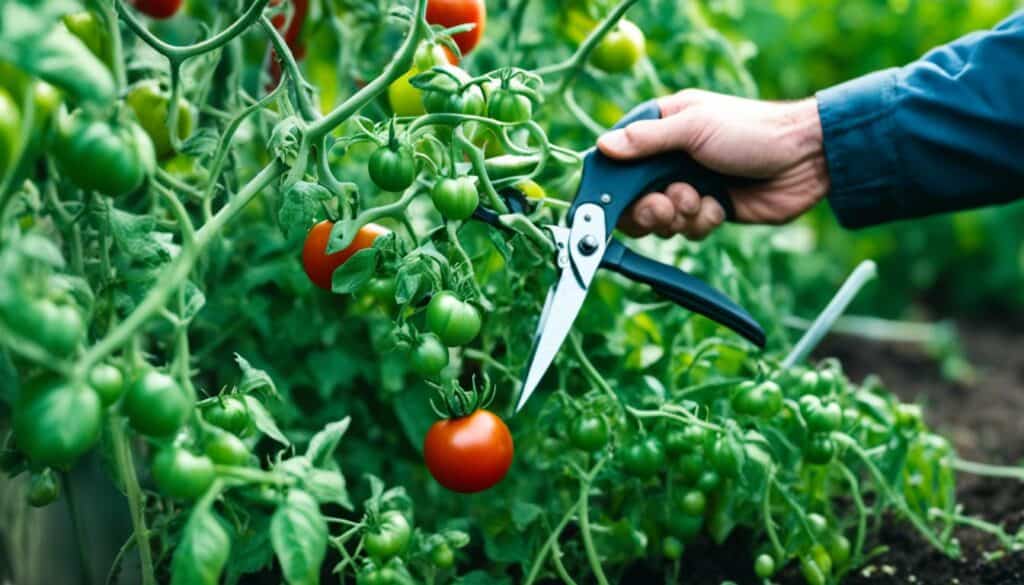
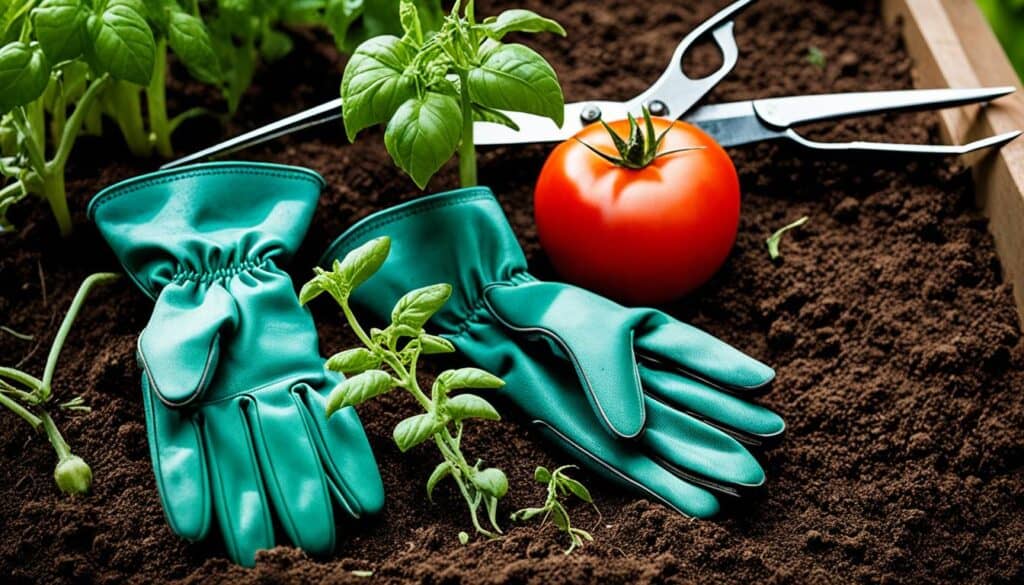
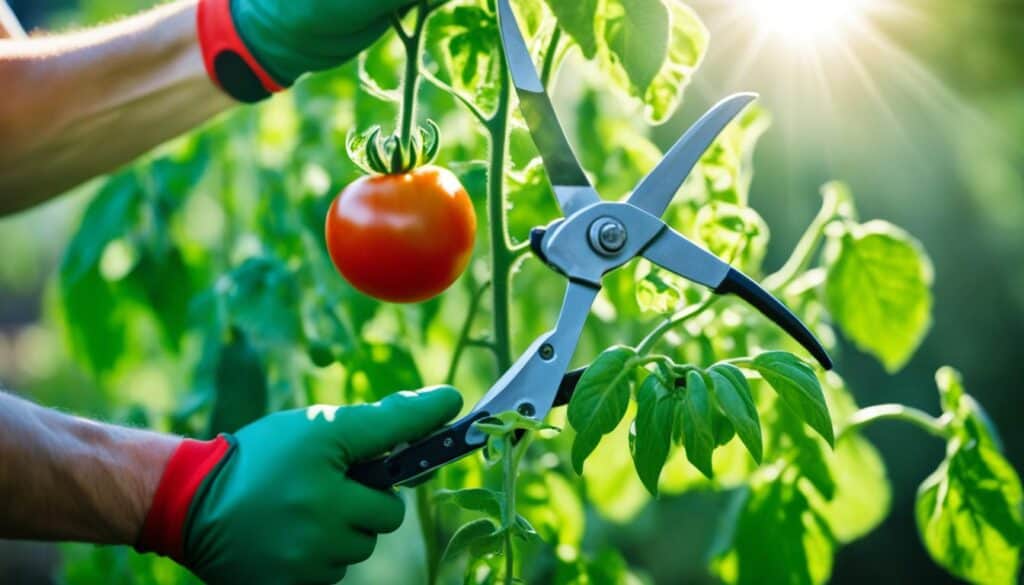

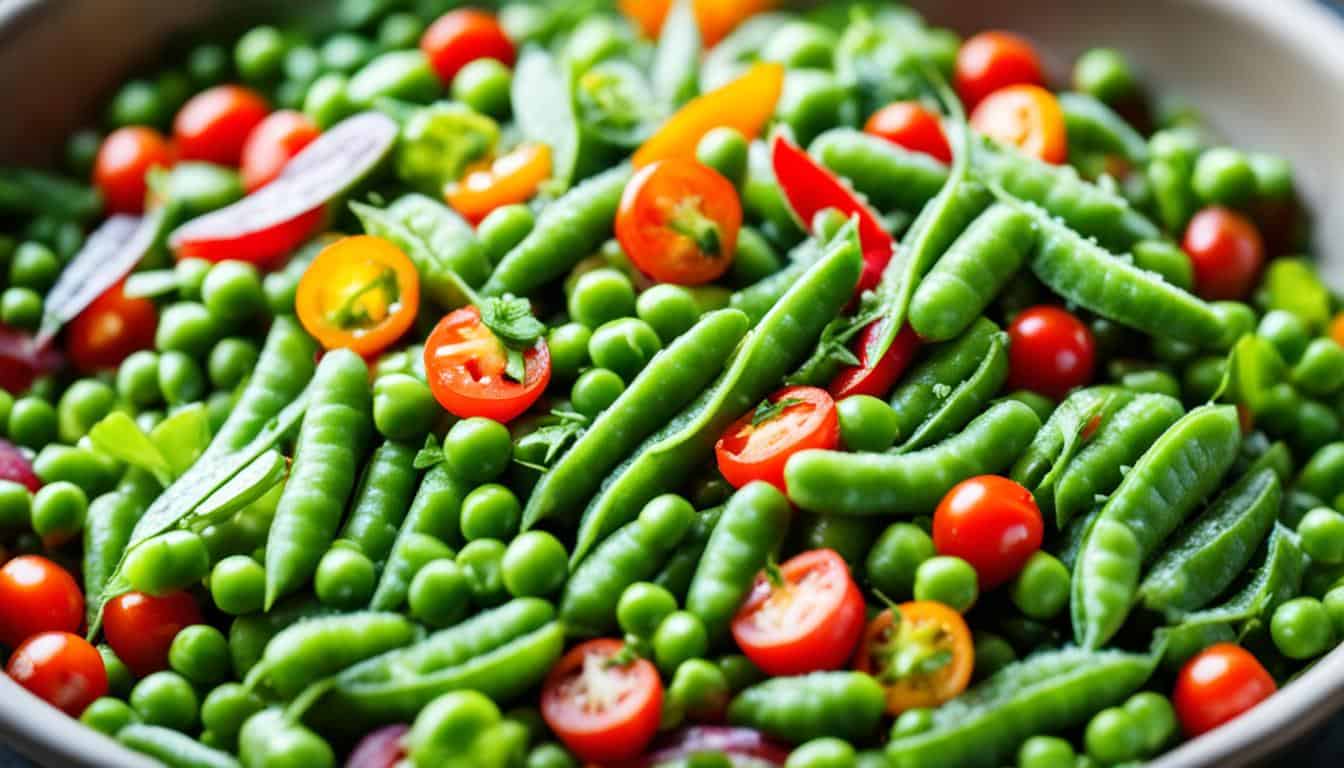
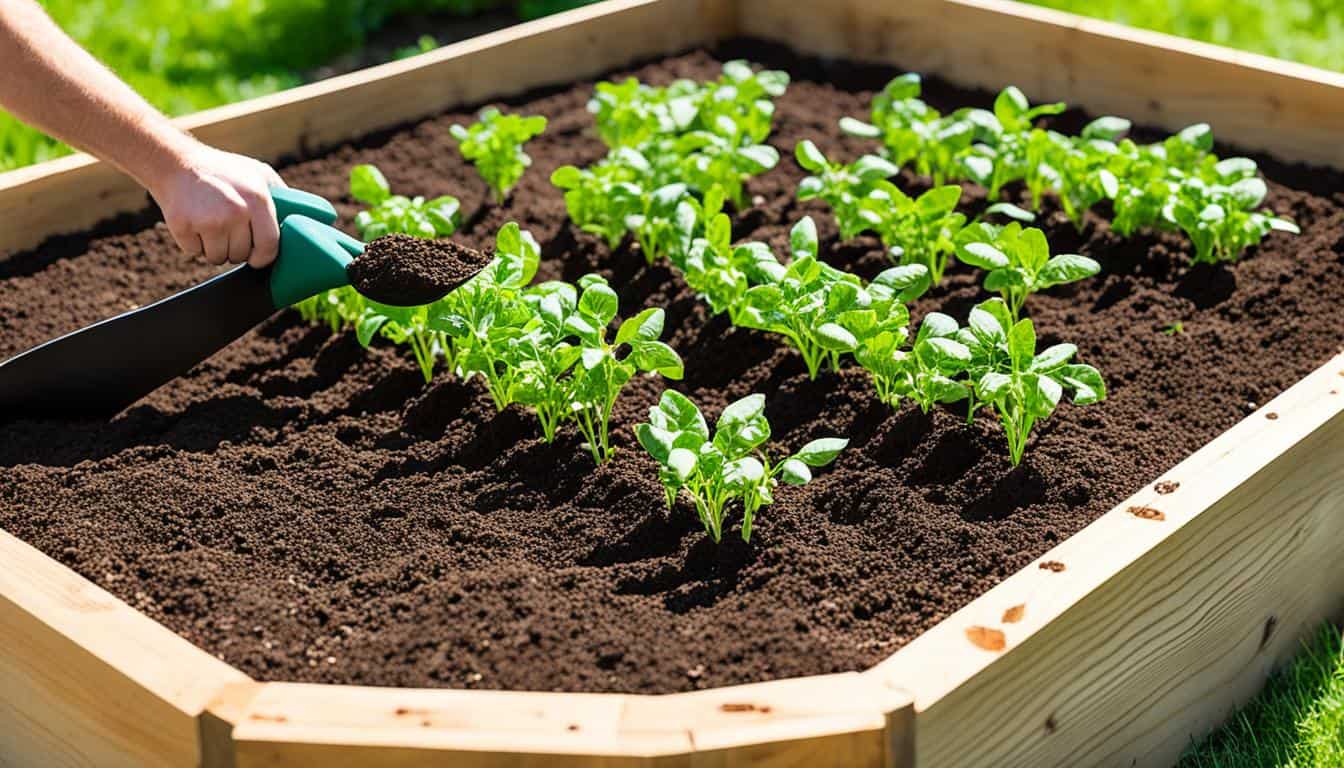
Leave a Reply